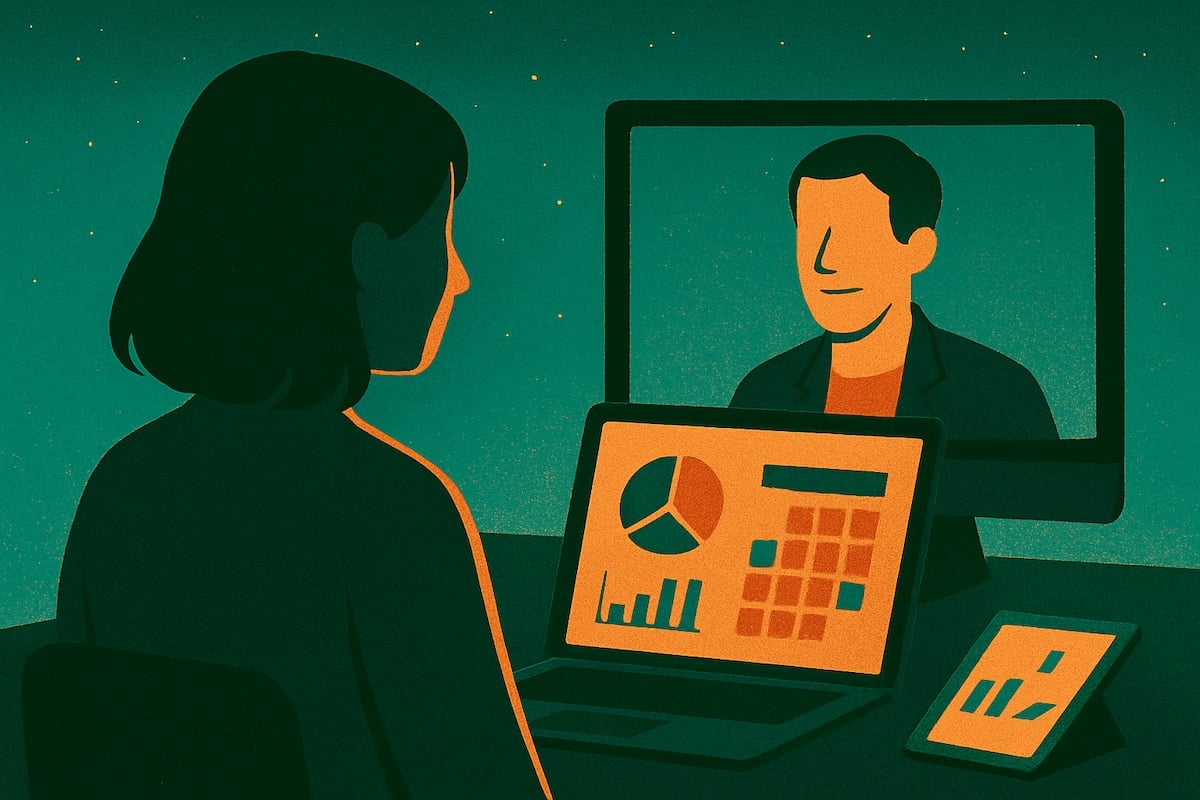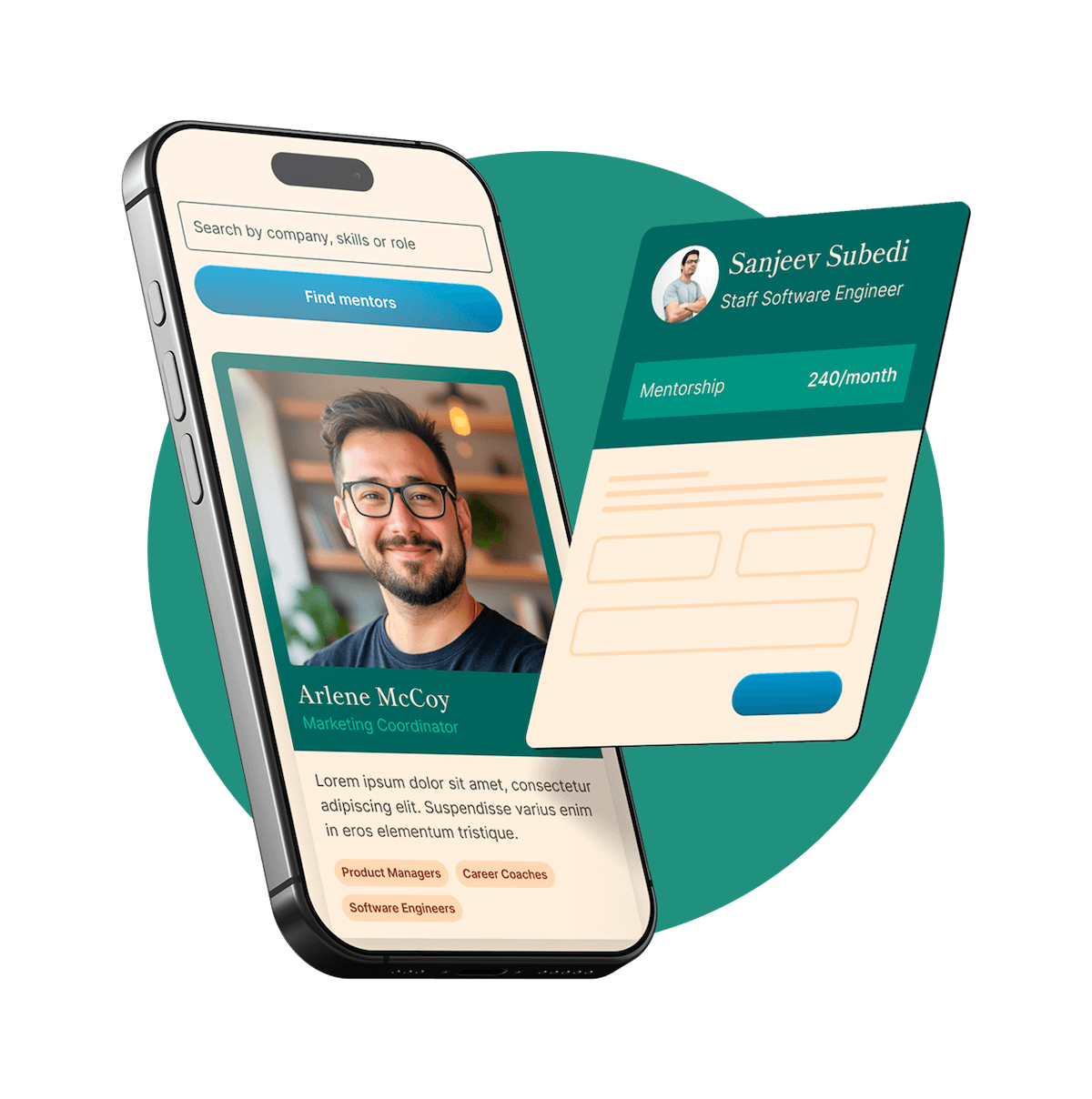Struggling to master UX Design on your own? Get mentored by industry-leading UX Design experts to mentor you towards your UX Design skill goals.













Want to start a new dream career? Successfully build your startup? Itching to learn high-demand skills? Work smart with an online mentor by your side to offer expert advice and guidance to match your zeal. Become unstoppable using MentorCruise.
Thousands of mentors available
Flexible program structures
Free trial
Personal chats
1-on-1 calls
97% satisfaction rate

5 out of 5 stars
"Having access to the knowledge and experience of mentors on MentorCruise was an opportunity I couldn't miss. Thanks to my mentor, I managed to reach my goal of joining Tesla."

5 out of 5 stars
"After years of self-studying with books and courses, I finally joined MentorCruise. After a few sessions, my feelings changed completely. I can clearly see my progress – 100% value for money."

One-off calls rarely move the needle. Our mentors work with you over weeks and months – helping you stay accountable, avoid mistakes, and build real confidence. Most mentees hit major milestones in just 3 months.
We don't think you should have to figure all things out by yourself. Work with someone who has been in your shoes.
Get pros to make you a pro. We mandate the highest standards for competency and communication, and meticulously vet every UX Design mentors and coach headed your way.
Master UX Design, no fluff. Only expert advice to help you hone your skills. Work with UX Design mentors in the trenches, get a first-hand glance at applications and lessons.
Why learn from 1 mentor when you can learn from 2? Sharpen your UX Design skills with the guidance of multiple mentors. Grow knowledge and open-mindedly hit problems from every corner with brilliant minds.
Pay for your UX Design mentor session as you go. Whether it's regular or one-off, stay worry-free about tuition or upfront fees.
Break the ice. Test the waters and feel out your UX Design mentor sessions. Can your coach teach the language of the coding gods passionately? With ease? Only a risk-free trial will tell.
No contracts means you can end, pause and continue engagements at any time with the greatest flexibility in mind
UX mentoring is a relationship where an experienced UX professional guides a less experienced designer through real work, skill building, and career choices. It is personal, practical, and focused on outcomes you can measure in your UX design career. As the UX Design Institute puts it, mentorship is a powerful tool for personal and professional development for both beginners and mentors who want to pay it forward.
UX mentoring is flexible by design. It can be formal or informal, short or long, remote or in person, senior to junior or peer to peer. The shape changes based on your goals, availability, and the experience gap. When done well, it accelerates learning, removes guesswork, and builds confidence that sticks.
Breaking into UX can feel noisy. Job titles overlap, tools change, and advice conflicts. A UX mentor helps you make sense of it, set a clear path, and take action without spinning your wheels. If you have ever felt like Dana Wu did at the start of her UX career, full of questions and fear with no one to ask, mentorship turns that uncertainty into momentum and clarity.
A mentor shortens your path from theory to practice. You get targeted design feedback, realistic side projects, and a plan for technical UX skills that match the work you want to do. That includes research planning, information architecture, prototyping, and usability testing with tools you will actually use on the job. This focused guidance helps you skip common beginner mistakes and start shipping work you can show.
Imposter feelings are common in UX. A mentor gives you a safe place to ask “obvious” questions, reflect on misses, and see progress in context. Confidence grows when you pair honest critique with quick wins and a steady cadence. Over time, you learn to judge your own work with clarity instead of doubt.
Mentors tune your path to the roles you want. You work on interview fundamentals, portfolio optimization, and salary negotiation. You also expand your network through warm intros and community engagement so your work reaches the right people. The result is a clearer story across your resume, your projects, and your interviews.
Mentorship is not one size fits all. Pick the point on this spectrum that fits your context and energy right now.
time commitment: light touch monthly check ins or weekly deep dives
formality: structured program with goals or informal chats that evolve
location: fully remote or occasional face to face sessions
experience gap: peer to peer for accountability or senior to junior for depth
focus area: research, prototyping, product strategy, content design, or technical UX
Use this spectrum to set expectations early so the relationship stays healthy and useful.
A strong UX mentor teaches thinking, not just steps. Expect a blend of coaching, critique, and accountability that fits your level.
clarifies goals and gaps so your plan is tight
gives design feedback on real work with concrete next steps
helps you choose side projects that prove skill and judgment
reviews your portfolio and case studies so your story lands
preps you for interviews and hiring exercises
shares patterns and pitfalls from real projects
This combination builds skill, judgment, and momentum.
You are investing time. Here is the return you can expect when the setup is solid.
You move faster when you can ask a focused question and get a precise answer. Mentors help you course correct in days rather than months. You also learn how to frame problems, test ideas, and document decisions like a pro.
You will choose projects that show real end to end thinking. That means a sharp problem statement, a clear research plan, strong artifacts, and a concise narrative that explains tradeoffs and impact. Your UX mentor helps you package work in a way that hiring teams trust.
You will make smarter calls about roles, industries, and timing. You will learn to negotiate from data and to position your strengths without fluff. That clarity compounds across your UX design career.
Confidence is earned through consistent practice and honest feedback. Mentorship gives you both, which lowers stress and raises your standard of work.
Mentorship pays mentors back as well. It sharpens leadership, deepens craft, and expands networks. Scott Hurff’s take is simple and useful here. Mentorship fosters resilience and a customer centric mindset while rewarding curiosity. That is exactly the mindset strong UX teams need.
better leadership and communication skills through teaching
deeper knowledge by explaining and testing ideas out loud
wider networks and a stronger reputation for helping others
the personal reward of paying it forward to the next wave of designers
If you are experienced and considering it, mentoring is meaningful work that strengthens the community.
In mentoring, the relationship is growth oriented and mentee driven. You bring goals, work, and questions. Your mentor guides you to your own answers and teaches judgment. Coaching can be more structured and performance oriented with set drills or frameworks. Both can help. Mentorship is often the better fit when you want ongoing perspective and independence.
Use a simple plan so you find a good match without wasting time.
Write down the outcome you want in the next quarter and the skills you need to get there. Be specific about time commitment, formality, location, and the experience gap you prefer. This clarity makes it easier for the right mentor to say yes.
Start where UX mentors share their work and thinking. Join communities, attend meetups, and engage on LinkedIn and X with thoughtful comments. Show up with questions and share your work so potential mentors can see your effort and style.
Platforms make it easier to compare expertise, availability, and reviews in one place. On MentorCruise you can filter UX mentors by skills such as research, prototyping, product strategy, or technical UX, set a budget, and book a short intro call to confirm fit. It is faster and safer than cold outreach because scope and expectations are clear from day one.
Keep your message tight and respectful. Share your goal, one reason you chose them, and a clear ask for a short call. Include a link to a recent artifact so they can prepare. Busy leaders appreciate focus and preparation.
Agreeing on a few basics up front avoids friction later. Use these prompts as your checklist.
time commitment: weekly, biweekly, or monthly sessions
format: live calls, async reviews, or a mix
goals: skill outcomes and project outcomes you can measure
artifacts: what you will ship and when you will share it
feedback style: direct and structured or exploratory and conversational
boundaries: hours, response expectations, and confidentiality
Write these down in a shared doc to keep both sides aligned.
A simple rhythm turns good intentions into progress. Here is a structure you can start with and adapt.
Discovery. You share goals, constraints, and a quick read on your current skills. Your mentor asks questions and maps a first draft plan.
Plan. You agree on checkpoints, artifacts, and a cadence. You define what success looks like for the next month.
Practice. You ship small exercises and real slices of work each week. You document decisions so your thinking is visible.
Review. You get specific feedback with an explanation of why it matters. You end each session with a short list of next steps.
Reflect. You record what you learned, what changed, and what to test next.
Iterate. You adjust the plan based on results and upcoming opportunities.
Between sessions you keep momentum with async check ins and quick code or Figma reviews.
These small moves make UX mentoring smoother and more productive.
start with quick catch ups when time is tight, then book deeper dives when needed
ask strategic questions that reveal thinking rather than only asking for fixes
use a drip approach to follow up with short updates instead of long reports
bring one artifact per session so feedback can go deep
summarize feedback in your own words to confirm understanding
close each session with one experiment to run before the next call
Portfolios that win interviews show thinking, not just pixels. Work with your mentor to choose projects that prove your approach end to end.
start from a real problem with clear constraints
show your research plan and the decisions it informed
include artifacts that are easy to scan rather than dumping everything
highlight tradeoffs, accessibility choices, and how you measured impact
write a short conclusion with limits and next steps
This is portfolio optimization that hiring teams appreciate because it reflects how real product work happens.
If you lead a UX team, you can formalize mentorship without heavy process. Aim for light structure that scales.
set shared goals for growth like stronger customer empathy and better decision quality
pair mentors and mentees based on complementary skills and interests
give mentors time and recognition so the work is sustainable
keep sessions focused on real work with clear takeaways
review outcomes quarterly and adjust pairs or goals as needed
The best programs encourage resilience and curiosity while keeping customers at the center.
Good intentions can still stall if you fall into these traps. Mentors and mentees both have jobs to do.
For mentees, avoid these mistakes:
showing up without artifacts or questions
collecting advice without implementing it
seeking step by step answers instead of learning to think
overloading your mentor with long DMs and no context
switching goals every week and resetting progress
For mentors, avoid these mistakes:
prescribing solutions instead of teaching problem solving
offering vague feedback that does not show what to change
hiding behind theory without demonstrating craft
ignoring constraints and setting goals that do not fit
overcommitting and then going silent
Naming these patterns early prevents frustration later.
Most first sessions cover goals, constraints, and a quick review of your current work. You leave with a short plan and one clear next step.
A course is fixed content. Mentorship adapts to your goals, gives feedback on your actual work, and holds you accountable.
You can feel momentum in one to two months when you practice each week and ship artifacts. Larger outcomes build as your projects stack up.
Yes. Mid career designers use mentorship to sharpen strategy, improve leadership, and break into new domains. The structure adapts to your level.
No. Group formats and peer circles work well when you want community and feedback on shared challenges.
If you want a fast, safe way to compare mentors and start quickly, use MentorCruise. You can browse vetted UX mentors by focus area, filter by budget, read reviews, and book a short intro call to confirm fit. It saves you time and lets you match with someone who fits your goals and schedule.
UX mentoring gives you structure, perspective, and confidence. Define your goals, choose the point on the mentorship spectrum that fits you, and commit to steady practice. If you are ready to work with a UX mentor who fits your needs, browse UX mentors on MentorCruise and book your intro call to get moving.
5 out of 5 stars
"My mentor gave me great tips on how to make my resume and portfolio better and he had great job recommendations during my career change. He assured me many times that there were still a lot of transferable skills that employers would really love."

The journey to excelling in UX Design can be challenging and lonely. If you need help regarding other sides to UX Design, we're here for you!
Our top-rated and hands-on UX Design coaches can help you become successful in your career and in mastering the wildly popular industry skill.
Our UX Design tutors can help you build your programming knowledge and devise study plans personalized for your needs.
UX Design experts are available to help you overcome any roadblocks that you have in the path towards success.
Our UX Design consultants provide strategic guidance and hands-on expertise to help transform your business.
Get access to UX Design training and corporate training through workshops, tutoring, and customized programs.
UX Designer can help provide professional advice and insider knowledge on how to succeed in the industry.
Share your UX Design expertise, grow as a professional and make a real difference as a UX Design mentor on MentorCruise.
Find professional UX Design services and experts to help you with your next project or challenge.
Certifications are a great way to show your expertise in UX Design. Here are the best certifications you can get.
Join interactive UX Design workshops led by industry experts to gain hands-on experience and level up your skills.
Can't find the answer you're looking for? Reach out to our customer support team.
A: UX Design mentoring involves guidance from experienced design professionals to help you enhance your user experience skills. A UX mentor provides personalized advice on design principles, user research, prototyping, and career development, enabling you to create intuitive and user-friendly interfaces.
A: After selecting a mentor on MentorCruise, you’ll engage in one-on-one sessions through calls and personal chats. Your mentor will help with:
Design strategies, user research, and prototyping
Portfolio reviews and project critiques
Hands-on exercises and real-world design challenges
Career development and job search strategies
A: Working with a MentorCruise UX design mentor offers many advantages, including:
Personalized feedback to refine your design skills
Insights into industry trends and best practices
Assistance in building a compelling portfolio
Preparation for job interviews and career advancement
Expansion of your professional network
A: Here’s how you can find the right UX Design mentor on MentorCruise:
Outline your goals, whether it's enhancing your portfolio, mastering new tools, or getting career advice.
Evaluate profiles, skills, and reviews to find the right match.
Begin with a free trial to see if the mentorship aligns with your needs.
A: UX design courses provide structured lessons, while UX mentorship is personalized and hands-on. A mentor tailors feedback, career advice, and project critiques to your needs, making it more effective for practical skill-building and job readiness.
A: Yes. Mentors provide detailed feedback on your portfolio, suggest improvements, and help you create compelling case studies that highlight your design skills and process.
A: Yes, UX Design mentoring can help you transition into UX design by teaching essential skills, guiding portfolio development, and providing job market insights.
A: Depending on your goals, mentors can help you master industry-standard tools such as Figma, Sketch, Adobe XD, and other prototyping and user research software.
We've already delivered 1-on-1 mentorship to thousands of students, professionals, managers and executives. Even better, they've left an average rating of 4.9 out of 5 for our mentors.
Book a UX Design mentor